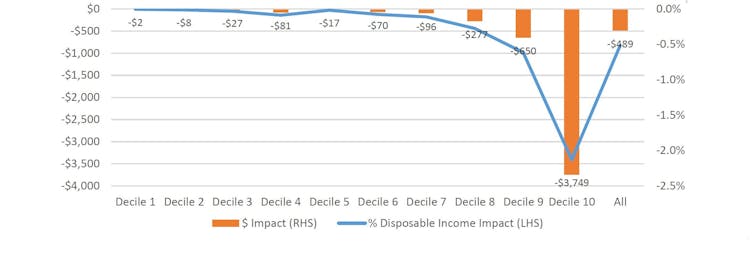Labor is banking on about $5 billion per year from ending the cash payment of company tax refunds to dividend holders who don’t pay tax.
It’ll exempt charities, non-profits, pensioners and part-pensioners and other Australians on government allowances, including future pensioners. Self-managed super funds that had pensioner members at the time Labor announced its policy will also be spared.
So who’s left? Are they battlers on genuinely low incomes (as might be inferred from the low taxable incomes that enable them not to pay tax), or are they a good deal more wealthy?
The Coalition says they are mainly genuine low-income earners. According to Treasurer Josh Frydenberg more than 80 per cent of people who are relying on their cash refunds have a taxable income under $37,000.
Yet Labor’s Chris Bowen says they are typically wealthier retirees who aren’t paying income tax – these are people who typically own their own home and also have other tax-free superannuation assets, and don’t pay tax on their superannuation income
There are two main ways in which people receive company tax refunds that are paid in cash rather deducted from their tax bill.
One is through self-managed super funds that don’t pay tax during the retirement phase. Around 55 per cent of excess refunds are paid out in this way according to our modelling.
The other is through payments made directly to Australians who own Australian shares but pay insufficient tax to make use of company tax credits. These can be retirees whose taxable incomes are low or zero (and not reported to the Tax Office) because superannuation income is non taxable.
Read more:
Words that matter. What’s a franking credit? What’s dividend imputation? And what’s ‘retiree tax’?
Modelling just completed by the Australian National University Centre for Social Research and Methods attempts to gets around the lack of Tax Office data by using household income data reported to the Bureau of Statistics.
Household income also includes superannuation income whether it is taxed or not. It can also be a better guide to who benefits from shares held within a household because they are typically held in the name of the lowest taxed member.
Our findings are presented in 2019 dollars and are based on a “mature” policy in the sense that the behavioural changes expected by the Parliamentary Budget Office have taken place. We accept that such changes are subject to considerable uncertainty but expect the distribution of results to hold up regardless.
Who gets the cheques?
Across all households, regardless of whether they receive dividend imputation cheques, the average impact from removing the credits would be $489 per year, or about 0.5 per cent of disposable income.
But the impact of Labor’s policy is heavily concentrated in households in the top 10 per cent (decile 10) of household incomes. These households would pay an average additional tax of $2641 per year (1.1 per cent of their disposable income).
There would be virtually no impact on households in the bottom half of the income distribution.
Impact of proposed changes to franking credit policy on annual household disposable income by equivalised income decile, 2019 dollars

Source: PolicyMod, ANU
The impact is even more skewed when considered by wealth distribution of households.
Labor’s changes would have virtually no impact across the bottom 70 per cent of the wealth distribution. Almost 90 per cent of the total value of all imputation cheques are paid to the top 20 per cent of the wealth distribution.
Around 2.7 per cent are paid to the bottom 50 per cent.
Impact of proposed changes to franking credit policy on annual disposable household income by wealth decile, 2019 dollars

Source: PolicyMod, ANU
Overall, around 6.5 .per cent of households would be negatively impacted (around 600,000 households). The vast majority have high income and high wealth.
For the low income or low wealth households that would be affected, the impact tends to be relatively small. As an example, for the least wealthy 10 per cent who receive imputation cheques the average financial impact is $686 per year. For the most wealthy it is nearly $12,000 per year.
The interaction of superannuation and Australia’s present dividend imputation system leads to significant tax leakage. Whether removing excess franking credits is the right solution is debatable, but it remains the case that the majority of excess imputation payments go to high income and/or high wealth households who ideally would be paying at least some tax on what they earned.![]()
Ben Phillips, associate professor, Centre for Social Research and Methods, Director, Centre for Economic Policy Research (CEPR), Australian National University and Matthew Gray, director, ANU Centre for Social Research and Methods, Australian National University
This article is republished from The Conversation under a Creative Commons license. Read the original article.








